Intel SSD DC P3700 Review: The PCIe SSD Transition Begins with NVMe
by Anand Lal Shimpi on June 3, 2014 2:00 AM EST- Posted in
- Storage
- SSDs
- Intel
- Intel SSD DC P3700
- NVMe
Random Read Performance
Although sequential performance is important, a true staple of any multi-user server is an IO load that appears highly random. For our small block random read test we first fill all drives sequentially, then perform one full drive write using a random 4K pass at a queue depth of 128. We then perform a 3 minute random read run at each queue depth, plotting bandwidth and latency along the way.
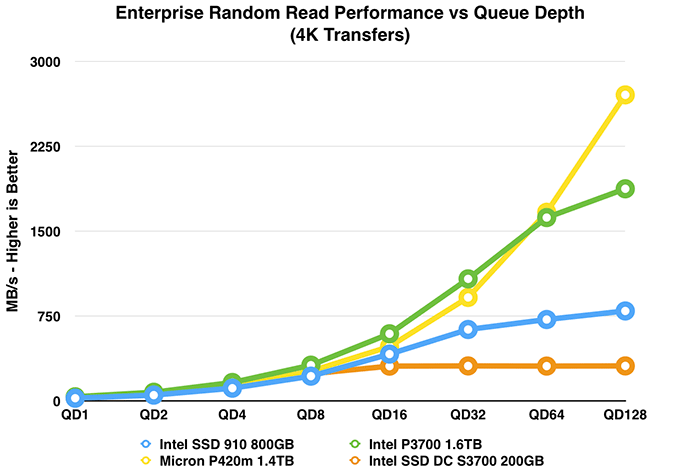
Small block random read operations have inherent limits when it comes to parallelism. In the case of all of the drives here, QD1 performance ends up around 20 - 40MB/s. The P3700 manages 36.5MB/s (~8900 IOPS) compared to 27.2MB/s (~6600 IOPS) for the SATA S3700. Even at a queue depth of 8 there's only a small advantage to the P3700 from a bandwidth perspective (~77000 IOPS vs. ~58400 IOPS). Performance does scale incredibly well with increasing queue depths though. By QD16 we see the P3700 pull away, at even as low as QD32 the P3700 delivers roughly 3.5x the performance of the S3700. There's a 70% advantage at QD32 compared to Intel's SSD 910, but that advantage grows to 135% at QD128.
Micron's P420m is incredibly competitive, substantially outperforming the P3700 at the highest queue depth.
Random read latency is incredibly important for applications where response time matters. Even more important for these applications is keeping latency below a certain threshold, what we're looking for here is a flat curve across all queue depths:
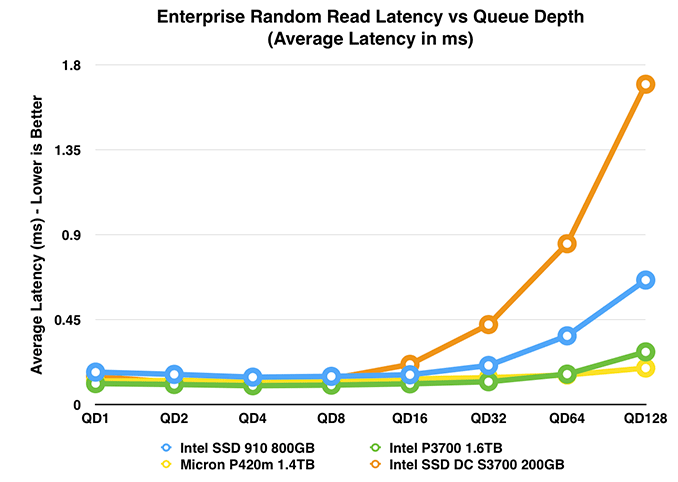
And that's almost exactly what the P3700 delivers. While the average latency for Intel's SSD DC S3700 (SATA) sky rockets after QD32, the P3700 remains mostly flat throughout the sweep. It's only at QD128 that we see a bit of an uptick. Even the 910 shows bigger jumps at higher queue depths.
If we remove the SATA drive and look exclusively at PCIe solutions, we get a better idea of the P3700's low latencies:
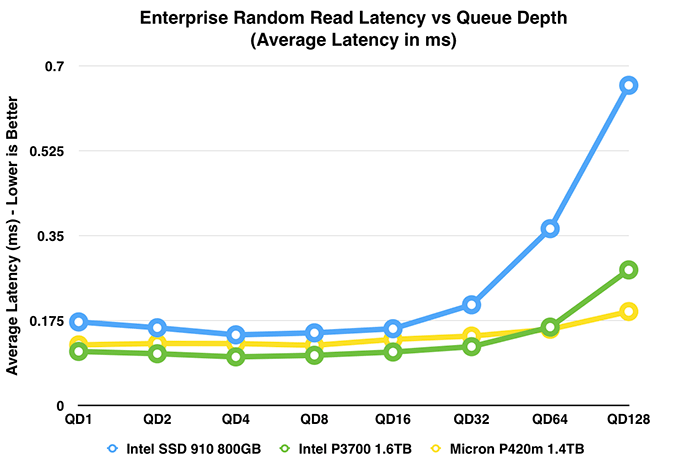
In this next chart we'll look at some specific numbers. Here we've got average latency (expressed in µs) for 4KB reads at a queue depth of 32. This is the same data as in the charts above, just formatted differently:
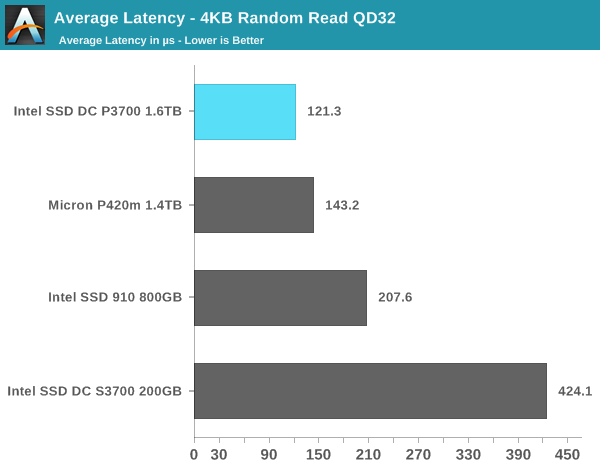
The P3700's latency advantage over its SATA counterpart is huge. Compared to other PCIe solutions, the P3700 is still leading but definitely not by as large of a margin. Micron's P420m comes fairly close.
Next up is average latency, but now at our highest tested queue depth: 128.
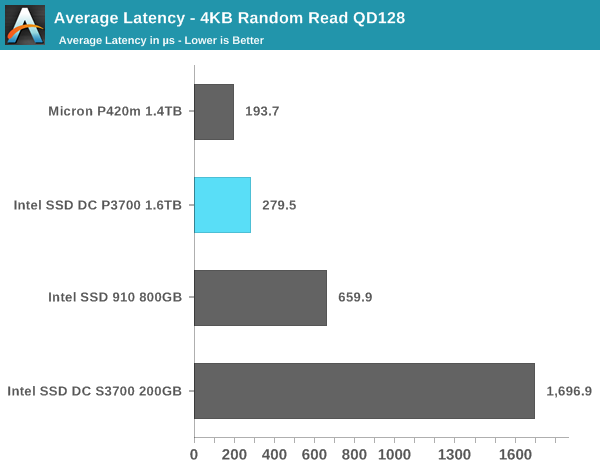
Micron's P420m definitely takes over here. Micron seems to have optimized the P420m for operation at higher queue depths while Intel focused the P3700 a bit lower. The SATA based S3700 is just laughable here, average completion latency is over 1.6ms.
Looking at maximum latency is interesting from a workload perspective, as well as from a drive architecture perspective. Latency sensitive workloads tend to have a max latency they can't exceed, but at the same time a high max latency but low average latency implies that the drive sees these max latencies infrequently. From an architectural perspective, consistent max latencies across the entire QD sweep give us insight into how the drive works at a lower level. It's during these max latency events that the drive's controller can schedule cleanup and defragmentation routines. I recorded max latency at each queue depth and presented an average of all max latencies across the QD sweet (From QD1 - QD128). In general, max latencies remained consistent across the sweep.
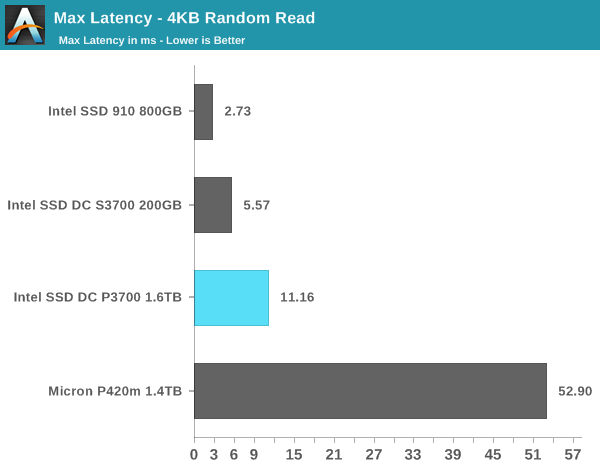
The 910's max latencies never really get out of hand. Part of the advantage is each of the 910's four controllers only ever see a queue depth of 32, so no individual controller is ever stressed all that much. The S3700 is next up with remarkably consistent performance here. The range of values the S3700 had was 2ms - 10ms, not correlating in any recognizable way to queue depth. Note the huge gap between max and average latency for the S3700 - it's an order of magnitude. These high latency events are fairly rare.
The P3700 sees two types of long latency events: one that takes around 3ms and another that takes around 15ms. The result is a higher max latency than the other two Intel drives, but with a lower average latency than both it's still fairly rare.
Micron's P420m runs the longest background task routine of anything here, averaging nearly 53ms. Whatever Micron is doing here, it seems consistent across all queue depths.
Random Write Performance
Now we get to the truly difficult workload: a steady state 4KB random write test. We first fill the drive to capacity, then perform a 4KB (QD128) random write workload until we fill the drive once more. We then run a 3 minute 4KB random write test across all queue depths, recording bandwidth and latency values. This gives us a good indication of steady state performance, which should be where the drives end up over days/weeks/months of continued use in a server.
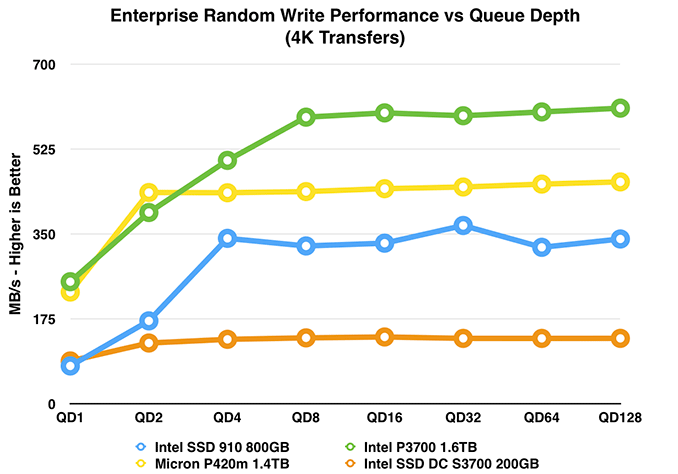
Despite the more strenuous workload, the P3700 absolutely shines here. We see peak performance attained at a queue depth of 8 and it's sustained throughout the rest of the range.
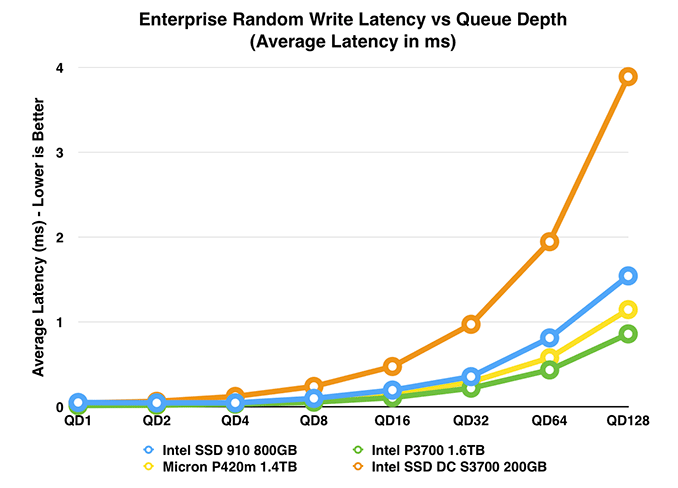
Average latency is also class leading - it's particularly impressive when you compare the P3700 to its SATA counterpart.
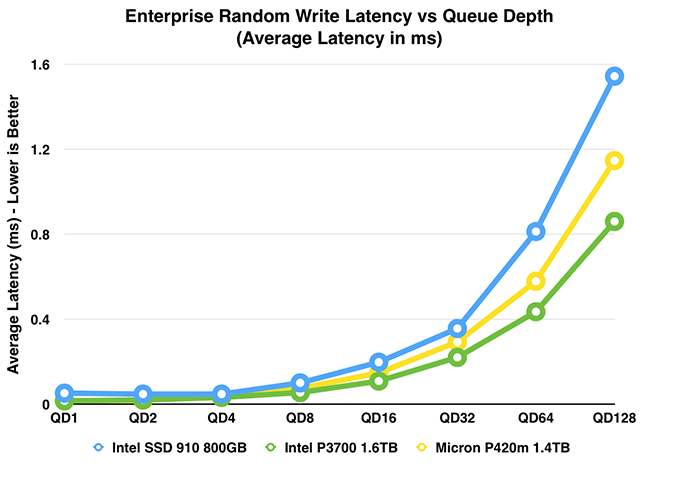
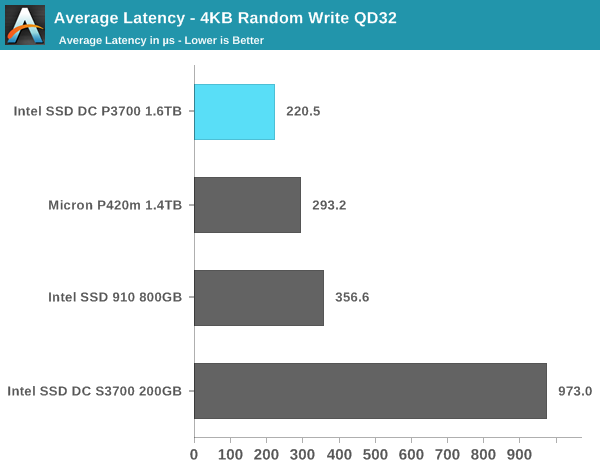

The absolute average latency numbers are particularly impressive. The P3700 at a queue depth of 128 can sustain 4KB random writes with IOs completing at 0.86ms.











85 Comments
View All Comments
jamescox - Monday, June 9, 2014 - link
"Why isn't the new spec internal thunderbolt?"Thunderbolt is PCI-e x4 multiplexed with display port. Intel's new SSD is PCI-e x4. I don't think we have a reason to route display port to an SSD, so thunderbolt makes no sense. Was this sarcasm that I missed?
"At some point the hard drive should be replaced by a PCI-express full length card that accepts NAND cards, and the user simply buys and keeps adding cards as space is required. This can already be done with current technology, no reinventing the wheel required."
What protocol are the NAND cards going to use to talk to the controller? There are many engineering limitations and complexities here. Are you going to have 18 channel controller like this new Intel card? If you populate channels one at a time, then it isn't going to perform well until you populate many of the channels. This is just like system memory; quad channel systems require 4 modules from the start to get full bandwidth. It gets very complicated unless each "NAND card" is a full pci-e card by itself. Each one being a separate pci-e card is no different from just adding more pci-e cards to your motherboard. Due to this move to pci-e, motherboard makers will probably be putting more x4 and/or x8 pci-e slots with different spacing from what is required by video cards. This will allow users to just add a few more cards to get more storage. It may be useful for small form factor systems to make a pci-e card with several m.2 slots since several different types of things (or sizes of SSDs) can be plugged into it. This isn't going to perform as well as having the whole card dedicated to being a single SSD though. I don't think you can fit 18 channels on an m.2 card at the moment.
Anyway, most consumer applications will not really benefit from this. I don't think you would see too much difference in "everyday usability" using a pci-e card vs. a fast sata 6 drive. Most consumer applications are not going to even stress this card. I suspect that sata 6 SSDs wil be around for a while. The SATA Express connector seems like a kludge though. If you actually need more performance than sata 6 (for what?), just get the pci-e card version.
jeffbui - Thursday, June 5, 2014 - link
"I long for the day when we don't just see these SSD releases limited to the enterprise and corporate client segments, but spread across all markets"Too bad Intel is all about profit margin. Having to compete on price (at low profit margins) gives them no incentive to go into the consumer space.
sethk - Saturday, June 7, 2014 - link
Hi Anand,Long time fan and love your storage and enterprise articles, including this one. One questions - what the driver situation on NVMe as far as dropping one of these into existing platforms (consumer and enterprise) and being able to boot?
Another question is regarding cabling for the non-direct PCIe interfaces like SataExpress and SFF-8639? It would be great if you could have some coverage of these topics and timing for consumer availability when you do your inevitable articles on the P3600 and P3500 which seem like great deals given the performance.
T2k - Monday, June 16, 2014 - link
How come you did not include ANY Fusion-IO card? In enterprise space they are practically cheaper than the P3700 and have far bigger sizes, for less money, consistently low latency, not to mention advanced software to match it... was it a request from Intel to leave them out?SeanJ76 - Wednesday, May 20, 2015 - link
Intel has always been the best in SSD performance, and longevity. I own 3 of the 520 series(240GB) and have never had a complaint.